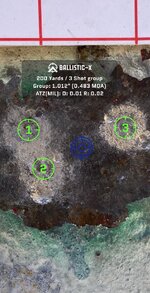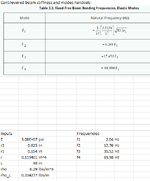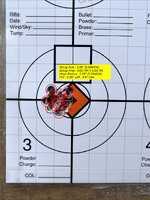This is a fair point. It's possible that the only way to achieve significant differences in bullet time are by changing components, and this is the best knob to tune a load. However, short of resolving issues with engraving or bullet imbalance, I still maintain the mechanism by which this works is by moving bullet time around relative to barrel dynamic motion.
Looking at my data only for my current combo of components, here is what I did to arrive at this load, all components and dimensions held constant.
First sweep was a powder sweep of 3 shots each in 1gr increments from 50.5 to 57.5 (24rds), groups were:
- 50.5, 0.90"
- 51.5, 0.35
- 52.5, 0.40"
- 53.5, 0.90"
- 54.5, 1.00"
- 55.5, 0.50"
- 56.5, 1.00", faint ejector marks
- 57.5, 0.70", strong ejector marks
My interpretation of this was a pattern of larger and smaller groups with nodes at or around 52.0 and 55.5. Also large differences ~100% between groups. So my next sweep was sets of 5 centered on these charge weights (30rds):
- 51.5, 0.65"
- 52.0, 0.50"
- 52.5, 0.40"
- 55.0, 0.60"
- 55.5, 0.65"
- 56.0, 0.50"
So, charges tested twice did increase in size, as one would expect going from 3 to 5 shot groups. However the accuracy was still acceptable, they didn't grow 100%, and 51.5, 52.5, and 55.5 had held up to 8 shots of testing and still showed small groups. 51.5-52.5 would likely be the most accurate, but I picked 55.5 for significantly higher MV and to stay away from pressure and poor accuracy above 56.0.
Since then I've used 55.5 and now have 51 shots banked and informing the stats I've quoted repeatedly here. Mean radius of 0.27 corresponds to a mean 3 shot group of 0.54", which I think also agrees with what this initial testing showed.



